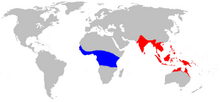| Oecophylla longinoda | |
|---|---|

| |
| In Morogoro, Tanzania | |
| Scientific classification | |
| Domain: | Eukaryota |
| Kingdom: | Animalia |
| Phylum: | Arthropoda |
| Class: | Insecta |
| Order: | Hymenoptera |
| Family: | Formicidae |
| Subfamily: | Formicinae |
| Genus: | Oecophylla |
| Species: | O. longinoda |
| Binomial name | |
| Oecophylla longinoda Latreille, 1802 | |

| |
| Oecophylla range map. O. longinoda in blue, O. smaragdina in red. | |

Oecophylla longinoda (common name weaver ant) is a species of arboreal ant found in the forested regions of tropical Africa. They are one of only two extant species of the genus Oecophylla, the other being O. smaragdina. They make nests in trees made of leaves stitched together using the silk produced by their larvae.
Description
The worker is a fairly large ant with a length of 6 mm (0.24 in). The antennae have twelve segments, the first segment exceeding in length the second and third combined. The clypeus, at the front of the head, is large and convex and overhangs the outer edge of the mouthparts. The large mandibles have long triangular teeth which cross over one another when the ant is at rest. This ant ranges in colour from orangeish-brown to dark brown; the thorax is clad in fine pubescence while the abdomen is covered with short erect hairs. The tip of the abdomen has glands that produce pheromones. The feet have suction pads which enables these ants to cling to surfaces with a firm grip.
Distribution and habitat
This weaver ant is widely distributed across the rainforests of sub-Saharan Africa. It is found high in the canopy and one colony can dominate the crown of one tree or spread across several trees.
Life cycle
After her nuptial flight, a newly mated queen founds a colony in an out of the way part of the canopy. At first she guards the eggs and cares for the growing larvae herself, feeding them out of her bodily reserves, and not going out to forage. She may lose 60% of her body weight during this period. When fully grown the larvae pupate, finally emerging as adult workers about thirty days after the eggs were laid. The workers now take over the building of nests and the care of the young, and the queen devotes herself to the laying of eggs, producing some hundred a day.
Ecology
A weaver ant colony consists of a large number of nests between which ants move at will. The nests are made by binding leaves together using silk produced by the final stage larvae. The queen inhabits one of these nests while the others are used by the worker ants to live in and care for the brood. The ants occupy a three dimensional territory in the treetops, driving off other ants of their own or other species aggressively, and usually creating a "no-ants-land" where the territory abuts on that of another colony. They are voracious predators, foraging on the ground as well as in the trees for insects and other arthropods, and co-operating with each other to tackle large prey. They also feed on the honeydew produced by scale insects, and the ants maintain herds of scale insect for this purpose.
O. longinoda is a natural enemy of the coconut bug (Pseudotheraptus wayi), a pest that has caused up to 67% of the coconut crop in Tanzania to be lost. The weaver ant competes with other species of ant living among the coconut palms, and is sometimes displaced by the ground-based Pheidole megacephala. However, the weaver ant is considerably more effective as a biological pest control agent, and baits are used to selectively control P. megacephala, allowing the weaver ants to flourish and control the coconut bugs.
References
- ^ Dlussky, Gennady M.; Torsten Wappler & Sonja Wedmann (2008). "New middle Eocene formicid species from Germany and the evolution of weaver ants" (PDF). Acta Palaeontologica Polonica. 53 (4): 615–626. doi:10.4202/app.2008.0406.
- ^ Woodruff, T. (2001). "Oecophylla longinoda". Animal Diversity Web. Retrieved 1 January 2018.
- Hölldobler, Bert & Wilson, Edward O. (1990). The Ants. Harvard University Press. pp. 401–402. ISBN 978-0-674-04075-5.
- Barbosa, Pedro A. (1998). Conservation Biological Control. Elsevier. p. 272. ISBN 978-0-08-052980-6.
- Egonyu, James Peter; Ekesi, Sunday; Kabaru, Jacques & Irungu, Lucy (2014). "Biology of the coconut bug, Pseudotheraptus wayi, on French beans". Journal of Insect Science. 14 (1): 44. doi:10.1093/jis/14.1.44. PMC 4206236. PMID 25373191.
External links
 Media related to Oecophylla longinoda at Wikimedia Commons
Media related to Oecophylla longinoda at Wikimedia Commons Data related to Oecophylla longinoda at Wikispecies
Data related to Oecophylla longinoda at Wikispecies
| Taxon identifiers | |
|---|---|
| Oecophylla longinoda | |